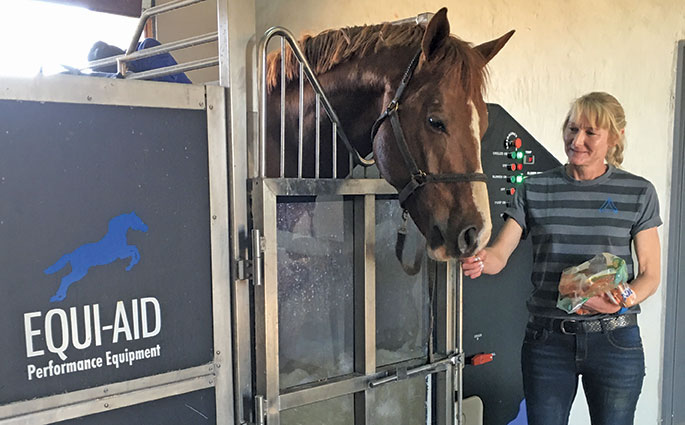
Photo: Dr Mac
Horse owners have always hosed down the legs of horses with sprains and strains. Those who live near the sea have found that swimming in salt water has helped injured racehorses recover from injury more quickly.
Due to the benefits of salt water treatment, new technology has resulted in the development of equine spa therapy.
Equine spa
An equine spa is a metal unit with doors at both ends and a rubberised floor. Horses are led into the unit, the doors are closed and the unit is sealed.
The spa is then slowly filled with cold water that is swirled around the horse’s legs until the water reaches just above the knees and hocks. This takes three to five minutes.
The temperature of the water and the speed at which it circulates is controlled by a computer and adjusted to the particular type of injury in consultation with an equine physiotherapist and a vet.
The hypotonic effect of salt water is an important part of treatment, and so different concentrations of salt are added.
Each treatment takes between 10 and 20 minutes and may be repeated one or more times a day. When the treatment is finished, the water is drained, the doors are opened and the horse is led out.
A full course of treatment generally lasts about 10 days, with the horse receiving the spa treatment once or twice every day. Lameness and swelling are usually greatly reduced by the eighth day.
Why does it work?
When an injury occurs, tissues are torn and bleeding occurs. Enzymes and inflammatory chemicals move to the injured site and diffuse through blood vessel walls into the injured area.
This causes heat and swelling, which acts to immobilise the injury. Pain will also prevent the horse from using the injured limb while it heals.
However, the pain and swelling can inhibit healing as they prevent blood and oxygen reaching the injured area. When anti-inflammatory medications and antibiotics are given to aid in healing, they may not reach the inflamed area due to poor circulation.
Cool water thus reduces the heat in the inflamed tissue, while the osmotic effect of the salt water affects the permeability of the vessels, reducing the swelling. The low temperature also reduces pain as the movement of the water gently massages the injured area.
A useful treatment
It is advised that the vet and physiotherapist work together. Ultrasound can be used to follow up on the progress made during healing. Hydrotherapy is most useful for acute injuries to the tendons and ligaments of the lower limbs, and has been shown to speed up healing, with less chance of relapse.
The positive effects of hydrotherapy on acute laminitis have also been documented. In general, acute injury to tissues, joints or muscles responds very well to hydrotherapy. It can also be used after surgery to speed up healing.
Moreover, the treatment is useful for degenerative joint disease or any condition that leads to swelling of the fetlocks, knees or hocks.
Hydrotherapy can be used as part of the training of performance horses before a big event to decrease stiffness. This is usually done over two days with programmed exercise on an automatic walker.
It is also useful post competition for general stiffness and soreness.
Dr Mac is an academic, a practising equine veterinarian and a stud owner.










